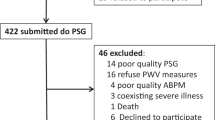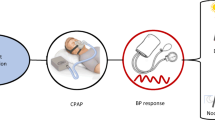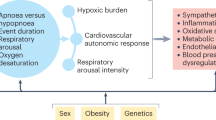Abstract
Obstructive sleep apnoea (OSA) and hypertension commonly coexist. Observational studies indicate that untreated OSA is strongly associated with an increased risk of prevalent hypertension, whereas prospective studies of normotensive cohorts suggest that OSA may increase the risk of incident hypertension. Randomized evaluations of continuous positive airway pressure (CPAP) indicate an overall modest effect on blood pressure (BP). Determining why OSA is so strongly linked to having hypertension in cross-sectional studies, but yet CPAP therapy has limited BP benefit needs further exploration. The CPAP studies do, however, indicate a wide variation in the BP effects of CPAP, with some patients manifesting a large antihypertensive benefit such that a meaningful BP effect can be anticipated in some individuals. OSA is particularly common in patients with resistant hypertension (RHTN). The reason for this high prevalence of OSA is not fully explained, but data suggest that it may be related to the high occurrence of hyperaldosteronism in patients with RHTN. In patients with RHTN, it has been shown that aldosterone levels correlate with severity of OSA and that blockade of aldosterone reduces the severity of OSA. Overall, these findings are consistent with aldosterone excess contributing to worsening of underlying OSA. We hypothesize that aldosterone excess worsens OSA by promoting accumulation of fluid within the neck, which then contributes to increased upper airway resistance.
This is a preview of subscription content, access via your institution
Access options
Subscribe to this journal
Receive 12 digital issues and online access to articles
$119.00 per year
only $9.92 per issue
Buy this article
- Purchase on Springer Link
- Instant access to full article PDF
Prices may be subject to local taxes which are calculated during checkout




Similar content being viewed by others
References
Fletcher EC, DeBehnke RD, Lovoi MS, Gorin AB . Undiagnosed sleep apnea in patients with resistant hypertension. Ann Intern Med 1985; 103: 190–195376.
Lavie P, Ben-Yosef R, Rubin AE . Prevalence of sleep apnea syndrome among patients with essential hypertension. Am Heart J 1984; 108: 373–376.
Worsnop CJ, Naughton MT, Barter CE, Morgan TO, Anderson Al, Pierce RJ . The prevalence of obstructive sleep apnea in hypertensives. Am J Respir Crit Care Med 1998; 157: 111–115.
Drager LF, Genta RP, Nerbass FB, Gonzagea CC, Krieger EM, Lorenzi-Filho G . Characteristics and predictors of obstructive sleep apnea in patients with systemic hypertension. Am J Cardiol 2010; 105: 1135–1139.
Baguet JP, Hammer L, Lévy P, Pierre H, Rossini E, Mouret S et al. Night-time and diastolic hypertension are common and underestimated conditions in newly diagnosed apnoeic patients. J Hypertens 2005; 23: 521–527.
Drager LF, Diegues-Silva L, Diniz MP, Bortolotto LA, Pedrosa RP, Couto RB et al. Obstructive sleep apnea, masked hypertension, and arterial stiffness in men. Am J Hypertens 2010; 23: 249–254.
Baguet JP, Levy P, Baron-Rochette G, Tamisier R, Pierre H, Peeters M et al. Masked hypertension in obstructive sleep apnea syndrome. J Hypertens 2008; 26: 885–892.
Young T, Peppard P, Palta M, Hla KM, Finn L, Morgan B et al. Population-based study of sleep-disordered breathing as a risk factor for systemic hypertension. Arch Intern Med 1997; 157: 1746–1752.
Lavie P, Herer P, Hoffstein V . Obstructive sleep apnoea syndrome as a risk factor for hypertension: population study. BMJ 2000; 320: 479–482.
Bixler EO, Vgontzas AN, Lin BK, Ten Have T, Leiby BE, Vela-Bueno A et al. Association of hypertension and sleep-disordered breathing. Arch Intern Med 2000; 160: 2289–2295.
Peppard PE, Young T, Palta M, Skatrud J . Prospective study of the association between sleep-disordered breathing and hypertension. N Engl J Med 2000; 342: 1378–1384.
O'Connor GT, Caffo B, Newman AB, Quan SF, Rapoport DM, Redline S et al. Prospective study of sleep-disordered breathing and hypertension: the Sleep Heart Health Study. Am J Respir Crit Care Med 2009; 179: 1159–1164.
Peppard PE . Is obstructive sleep apnea a risk factor for hypertension?—Differences between the Wisconsin Sleep Cohort and the Sleep Heart Health Study. J Clin Sleep Med 2009; 5: 404–405.
Bazzano LA, Khan Z, Reynolds K, He J . Effect of nocturnal nasal continuous positive airway pressure on blood pressure in obstructive sleep apnea. Hypertension 2007; 50: 417–423.
Alajmi M, Mulgrew AT, Fox J, Davidson W, Schulzer M, Mak E et al. Impact of continuous positive airway pressure therapy on blood pressure in patients with obstructive sleep apnea hypopnea: a meta-analysis of randomized controlled trials. Lung 2007; 185: 67–72.
Mo L, He QY . Effect of long-term continuous positive airway pressure ventilation on blood pressure in patients with obstructive sleep apnea hypopnea syndrome: a meta-analysis of clinical trials. Zhonghua Yi Xue Za Zhi 2007; 87: 1177–1180.
Haentjens P, Van Meerhaeghe A, Moscariello A, De Weerdt S, Poppe K, Dupont A et al. The impact of continuous positive airway pressure on blood pressure in patients with obstructive sleep apnea syndrome: evidence from a meta-analysis of placebo-controlled randomized trials. Arch Intern Med 2007; 167: 757–764.
Somers VK, Dyken ME, Clary MP, Abboud FM . Sympathetic neural mechanisms in obstructive sleep apnea. J Clin Invest 1995; 96: 1897–1904.
Narkiewicz K, Kato M, Phillips BG, Pesek CA, Davison DE, Somers VK . Nocturnal continuous positive airway pressure decreases daytime sympathetic traffic in obstructive sleep apnea. Circulation 1999; 100: 2332–2335.
Ishida K, Kato M, Kato Y, Yanagihara K, Kinugasa Y, Kotani K et al. Appropriate use of nasal continuous positive airway pressure decreases elevated C-reactive protein in patients with obstructive sleep apnea. Chest 2009; 136: 125–129.
de Lima AM, Franco CM, de Castro CM, Bezerra Ade A, Ataíde Jr L, Halpern A . Effects of nasal continuous positive airway pressure treatment on oxidative stress and adiponectin levels in obese patients with obstructive sleep apnea. Respiration 2010; 79: 370–376.
Phillips CL, Yang Q, Williams A, Roth M, Yee BJ, Hedner JA et al. The effect of short-term withdrawal from continuous positive airway pressure therapy on sympathetic activity and markers of vascular inflammation in subjects with obstructive sleep apnoea. J Sleep Res 2007; 16: 217–225.
Drager LF, Bortolotto LA, Figueiredo AC, Krieger EM, Lorenzi GF . Effects of continuous positive airway pressure on early signs of atherosclerosis in obstructive sleep apnea. Am J Respir Crit Care Med 2007; 176: 706–712.
Kitahara Y, Hattori N, Yokoyama A, Nakajima M, Kohno N . Effect of CPAP on brachial-ankle pulse wave velocity in patients with OSAHS: an open-labelled study. Respir Med 2006; 100: 2160–2169.
Calhoun DA, Jones D, Textor S, Goff DC, Murphy TP, Toto RD et al. Resistant hypertension: a scientific statement from the American Heart Association Professional Education Committee of the Council for High Blood Pressure Research. Hypertension 2008; 51: 1403–1419.
Dernaika TA, Kinasewitz GT, Tawk MM . Effects of nocturnal continuous positive airway pressure therapy in patients with resistant hypertension and obstructive sleep apnea. J Clin Sleep Med 2009; 5: 103–107.
Egan BM, Zhao Y, Rehman SU, Brzezinski WA, Clyburn B, Basile JN et al. Treatment resistant hypertension in a community-based practice network. J Clin Hypertens 2009; 11 (Supplement 1): 5.
McAdam-Marx C, Ye X, Sung JC, Brixner DI, Kahler KH . Results of a retrospective, observational pilot study using electronic medical records to assess the prevalence and characteristics of patients with resistant hypertension in an ambulatory care setting. Clin Ther 2009; 3: 1116–1123.
Cuspidi C, Macca G, Sampieri L, Michev I, Salerno M, Fusi V et al. High prevalence of cardiac and extracardiac target organ damage in refractory hypertension. J Hypertens 2001; 19: 2063–2070.
Muxfeldt ES, Bloch KV, Nogueira AR, Salles GF . Twenty-four hour ambulatory blood pressure monitoring pattern of resistant hypertension. Blood Press Monit 2003; 8: 181–185.
Pierdomenico SD, Lapenna D, Bucci A, Di Tommaso R, Di Mascio R, Manente BM et al. Cardiovascular outcome in treated hypertensive patients with responder, masked, false resistant and true resistant hypertension. Am J Hypertens 2005; 18: 1422–1428.
Isaksson H, Ostergren J . Prognosis in therapy-resistant hypertension. J Intern Med 1994; 236: 643–649.
Hirshkowitz M, Karacan I, Gurakar A, Williams RL . Hypertension, erectile dysfunction, and occult sleep apnea. Sleep 1989; 12: 223–232.
Grote L, Hedner J, Peter JH . Sleep-related breathing disorder is an independent risk factor for uncontrolled hypertension. J Hypertens 2000; 18: 679–685.
Lavie P, Hoffstein V . Sleep apnea syndrome: a possible contributing factor to resistant hypertension. Sleep 2001; 24: 721–725.
Martínez-García MA, Gómez-Aldaraví R, Gil-Martínez T, Soler-Cataluña JJ, Bernácer-Alpera B, Román-Sánchez P . Sleep-disordered breathing in patients with difficult-to-control hypertension. Arch Bronconeumol 2006; 42: 14–20.
Elias MR, Castro MCM, de Queiroz EL, Abensur H, Romão-Junior JE, Lorenzi-Fiho G . Obstructive sleep apnea in patients on conventional and short daily hemodialysis. Am J Nephrol 2009; 29: 493–500.
Logan AG, Perlikowski SM, Mente A, Tisler A, Tkacova R, Niroumand M et al. High prevalence of unrecognized sleep apnea in drug-resistant hypertension. J Hypertens 2001; 19: 2271–2277.
Gonçalves SC, Martinez D, Gus M, Oliveira de Abreu-Silva E, Bertoluci C, Dutra I et al. Obstructive sleep apnea and resistant hypertension: a case-control study. Chest 2007; 132: 1858–1862.
Pratt-Ubunama MN, Nishizaka MK, Boedefeld RL, Cofield SS, Harding SM, Calhoun DA . Plasma aldosterone is related to severity of obstructive sleep apnea in subjects with resistant hypertension. Chest 2007; 131: 453–459.
Calhoun DA, Nishizaka MK, Zaman MA, Thakkar RB, Weissmann P . Hyperaldosteronism among black and white subjects with resistant hypertension. Hypertension 2002; 40: 892–896.
Gallay BJ, Ahmad S, Xu L, Toivola B, Davidson RC . Screening for primary aldosteronism without discontinuing hypertensive medications: plasma aldosterone-renin ratio. Am J Kidney Dis 2001; 37: 699–705.
Eide IK, Torjesen PA, Drolsum A, Babovic A, Lilledahl NP . Low-renin status in therapy-resistant hypertension: a clue to efficient treatment. J Hypertens 2004; 22: 2217–2226.
Nishizaka MK, Zaman MA, Calhoun DA . Efficacy of low-dose spironolactone in subjects with resistant hypertension. Am J Hypertens 2003; 16: 925–930.
Chapman N, Dobson J, Wilson S, Dahlöf B, Sever PS, Wedel H et al. Effect of spironolactone on blood pressure in subjects with resistant hypertension. Hypertension 2007; 49: 839–845.
Calhoun DA, Nishizaka MK, Zaman MA, Harding SM . Aldosterone excretion among subjects with resistant hypertension and symptoms of sleep apnea. Chest 2004; 125: 112–117.
Gonzaga CC, Gaddam KK, Ahmed MI, Pimenta E, Thomas SJ, Harding SM et al. Severity of obstructive sleep apnea is related to aldosterone in subjects with resistant hypertension. J Clin Sleep Med 2010; 6: 363–368.
Raff H, Roarty TP . Renin, ACTH, and aldosterone during acute hypercapnia and hypoxia in conscious rats. Am J Physiol 1988; 254: R431–R435.
Svatikova A, Olson LJ, Wolk R, Phillips BG, Adachi T, Schwartz GL et al. Obstructive sleep apnea and aldosterone. Sleep 2009; 32: 1589–1592.
Gaddam K, Pimenta E, Thomas SJ, Oparil S, Harding SM, Calhoun DA . Spironolactone reduces severity of obstructive sleep apnea in patients with resistant hypertension: a preliminary report. J Hum Hypertens 2010; 24: 532–537.
Chiu KL, Ryan CM, Shiota S, Ruttanaumpawan P, Arzt M, Haight JS et al. Fluid shift by lower body airway positive pressure increases pharyngeal resistance in healthy subjects. Am J Respir Crit Care Med 2006; 174: 1378–1383.
Friedman O, Bradley TD, Chan CT, Parkes C, Logan AG . Relationship between overnight rostral fluid shift and obstructive sleep apnea in drug-resistant hypertension. Hypertension 2010; 56: 1077–1082.
Bucca CB, Brussino L, Battisti A, Mutani R, Rolla G, Mangiardi L et al. Diuretics in obstructive sleep apnea with diastolic heart failure. Chest 2007; 132: 440–446.
Logan AG, Tkacova R, Perlikowski SM, Leung RS, Tisler A, Floras JS et al. Refractory hypertension and sleep apnoea: effect of CPAP on blood pressure and baroreflex. Eur Respir J 2003; 21: 241–247.
Martínez-García MA, Gómez-Aldaraví R, Soler-Cataluña JJ, Martínez TG, Bernácer-Alpera B, Román-Sánchez P . Positive effect of CPAP treatment on the control of difficult-to-treat hypertension. Eur Respir J 2007; 29: 951–957.
Acknowledgements
This paper was supported by grants NHLBI SCCOR P50 HL077100, RO1-HL79040 and CCTS 5UL1 RR025777.
Author information
Authors and Affiliations
Corresponding author
Ethics declarations
Competing interests
The authors declare no conflict of interest.
Rights and permissions
About this article
Cite this article
Dudenbostel, T., Calhoun, D. Resistant hypertension, obstructive sleep apnoea and aldosterone. J Hum Hypertens 26, 281–287 (2012). https://doi.org/10.1038/jhh.2011.47
Received:
Revised:
Accepted:
Published:
Issue Date:
DOI: https://doi.org/10.1038/jhh.2011.47
Keywords
This article is cited by
-
Association between arterial stiffness and sleep apnoea in patients with resistant hypertension
Journal of Human Hypertension (2022)
-
Long-term effect of continuous positive airway pressure therapy on blood pressure in patients with obstructive sleep apnea
Scientific Reports (2021)
-
Associations between primary aldosteronism and diabetes, poor bone health, and sleep apnea—what do we know so far?
Journal of Human Hypertension (2020)
-
The neuropeptide substance P regulates aldosterone secretion in human adrenals
Nature Communications (2020)
-
Obstructive Sleep Apnea, Hypertension, and Cardiovascular Risk: Epidemiology, Pathophysiology, and Management
Current Cardiology Reports (2020)



